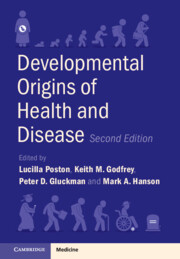Book contents
- Developmental Origins of Health and Disease
- Developmental Origins of Health and Disease
- Copyright page
- Contents
- Contributors
- Preface
- Section I Overview
- Section II Exposures Driving Long-Term DOHaD Effects
- Chapter 2 The Evolutionary Basis of DOHaD
- Chapter 3 Timing
- Chapter 4 Long-Term Effects of Food Insecurity and Undernutrition in Early Life
- Chapter 5 Short- and Long-Term Effects of Maternal Obesity and Dysglycaemia for Women and Their Children
- Chapter 6 Long-Term Effects of Prenatal Maternal Stress and Mental Health
- Chapter 7 Environmental Exposures in Early Life
- Chapter 8 Developmental Programming and the Microbiome
- Chapter 9 Exposures Driving Long-Term DOHaD Effects
- Section III Outcomes
- Section IV Mechanisms
- Section V Interventions
- Section VI Public Health and Policy Implications of Interventions
- Index
- References
Chapter 4 - Long-Term Effects of Food Insecurity and Undernutrition in Early Life
from Section II - Exposures Driving Long-Term DOHaD Effects
Published online by Cambridge University Press: 01 December 2022
- Developmental Origins of Health and Disease
- Developmental Origins of Health and Disease
- Copyright page
- Contents
- Contributors
- Preface
- Section I Overview
- Section II Exposures Driving Long-Term DOHaD Effects
- Chapter 2 The Evolutionary Basis of DOHaD
- Chapter 3 Timing
- Chapter 4 Long-Term Effects of Food Insecurity and Undernutrition in Early Life
- Chapter 5 Short- and Long-Term Effects of Maternal Obesity and Dysglycaemia for Women and Their Children
- Chapter 6 Long-Term Effects of Prenatal Maternal Stress and Mental Health
- Chapter 7 Environmental Exposures in Early Life
- Chapter 8 Developmental Programming and the Microbiome
- Chapter 9 Exposures Driving Long-Term DOHaD Effects
- Section III Outcomes
- Section IV Mechanisms
- Section V Interventions
- Section VI Public Health and Policy Implications of Interventions
- Index
- References
Summary
The Developmental Origins of Health and Disease (DOHaD) concept supports that the environment that you are exposed to in early life significantly impacts on both short- and longer-term health. As a modifiable exposure, diet and nutrition has been a major focus of DOHaD-related research. However, much of the focus has come from well-nourished settings with a focus on ‘optimizing’ the diet in early life for the prevention of obesity and long-term chronic disease risk. Far less attention has been given to the long-term health consequences of food insecurity and nutritional deprivation in early life.
- Type
- Chapter
- Information
- Developmental Origins of Health and Disease , pp. 27 - 37Publisher: Cambridge University PressPrint publication year: 2022



